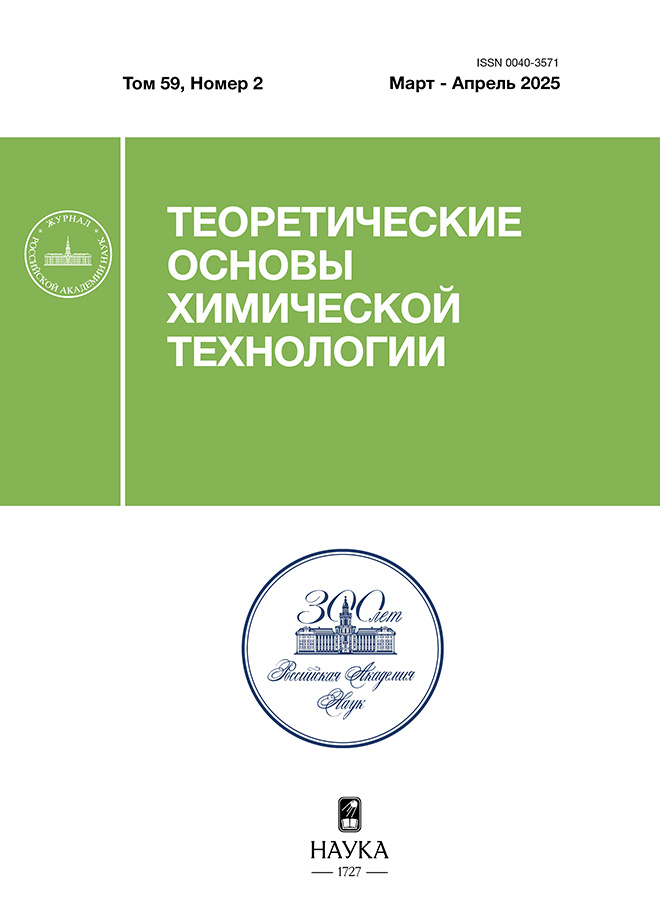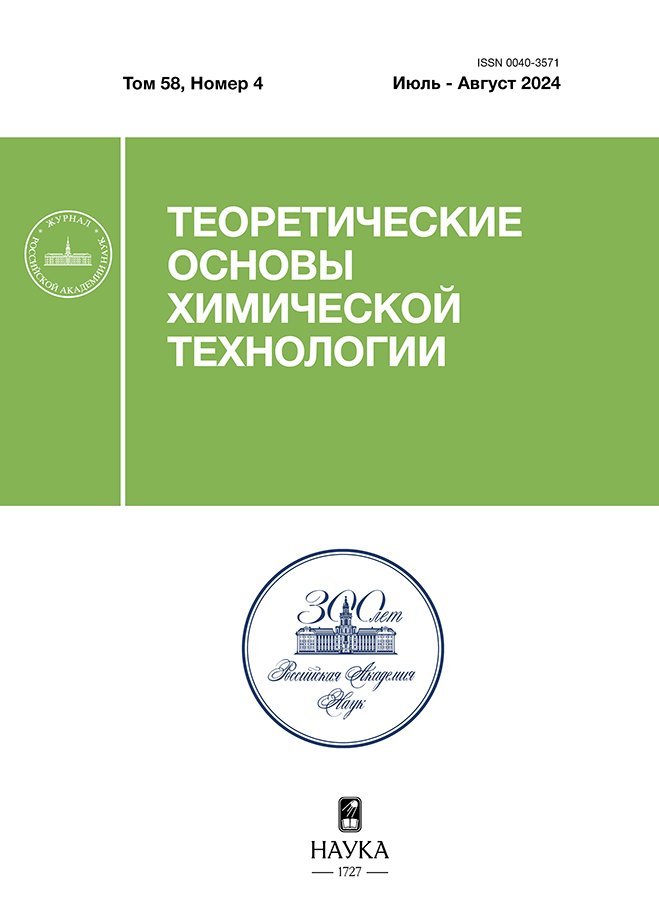Разработка двухфазной пузырьковой математической модели процесса окислительной регенерации катализатора крекинга
- Авторы: Назарова Г.Ю.1, Ивашкина Е.Н.1, Антонов А.В.1, Самсонов И.А.1
-
Учреждения:
- Национальный исследовательский Томский политехнический университет
- Выпуск: Том 58, № 4 (2024)
- Страницы: 458-471
- Раздел: Статьи
- Статья опубликована: 07.08.2024
- URL: https://rjdentistry.com/0040-3571/article/view/686058
- DOI: https://doi.org/10.31857/S0040357124040065
- EDN: https://elibrary.ru/awawfg
- ID: 686058
Цитировать
Полный текст
Аннотация
Данное исследование направлено на разработку математической модели процесса окислительной регенерации катализатора крекинга с учетом закономерностей протекания реакций, диффузии реактантов и гидродинамики процесса, с целью повышения эффективности технологии на основе моделирования полного цикла движения катализатора. С применением модели выполнена оценка границ существования пузырькового режима, параметров стабилизации кипящего слоя и оптимальных условий проведения процесса. Так, увеличение расхода воздуха до 27.8 м3/с приводит к росту рабочей скорости до 0.386 м/с, в связи с чем наблюдается разрушение кипящего слоя в регенераторе для частиц катализатора размером 4×10–5–1.6×10–4 м. Установлено, что для стабилизации кипящего слоя в регенераторе частиц размером 8×10–5–1×10–4 м расход воздуха не должен превышать 16.7 и 25 м3/с.
Ключевые слова
Полный текст
Об авторах
Г. Ю. Назарова
Национальный исследовательский Томский политехнический университет
Автор, ответственный за переписку.
Email: silko@tpu.ru
Россия, Томск
Е. Н. Ивашкина
Национальный исследовательский Томский политехнический университет
Email: silko@tpu.ru
Россия, Томск
А. В. Антонов
Национальный исследовательский Томский политехнический университет
Email: silko@tpu.ru
Россия, Томск
И. А. Самсонов
Национальный исследовательский Томский политехнический университет
Email: silko@tpu.ru
Россия, Томск
Список литературы
- Sildir H., Arkun Y., Canan U., Celebi S., Karani U., Er I. Dynamic modeling and optimization of an industrial fluid catalytic cracker // J. Process Control. 2015. V. 31. P. 30.
- Губайдуллин И.М., Дубинец О.В. Моделирование процесса окислительной регенерации с учетом влияния паров воды // Доклады Башкирского университета. 2020. Т. 5. № 5. С. 311.
- Сайфуллина Л.В., Еникеев М.Р., Губайдуллин И.М. Программное обеспечение для моделирования процесса окислительной регенерации на многопроцессорных вычислительных системах // Башкирский государственный университет. 2013. С. 10.
- Жоров Ю.М. Моделирование физико-химических процессов нефтепереработки и нефтехимии. М.: Химия, 1978. С. 376.
- Саитгалина А.Д., Юнусов А.А. Математическое моделирование процесса окислительной регенерации закоксованных катализаторов на кинетическом уровне с использованием GPGPU // Суперкомпьютерные центры и задачи: труды Международной суперкомпьютерной конференции, Новороссийск, 20–25 сентября 2010. Москва: МГУ им. М.В. Ломоносова. 2010. C. 149.
- Reshetnikov S.I., Petrov R.V., Zazhigalov S.V., Zagoruiko A.N. Mathematical modeling of regeneration of coked Cr-Mg catalyst in fixed bed reactors // Chem. Eng. J. 2019. V. 380. P. 220.
- Toomey R.D., Johnstone H.F. Gas Fluidization of Solid Particles // Chem. Eng. Prog. 1952. № 48. P. 220.
- Kunii D., Levenspiel O. Bubbling bed model: Model for the Flow of Gas through a Fluidized Bed // Ind. Eng. Chem. Fundam. 1968. V. 7. P. 446.
- Stephens, G.K., Sinclair, R.J., Potter, O.E. Gas exchange between bubbles and dense phase in a fluidized bed // Powder Technol. 1967. V. 1. P. 157.
- Kato K., Wen C.Y. Bubble assemblage model for fluidized bed catalytic reactors // Chem. Eng. Sci. 1969. V. 24. P. 1351.
- Han I.S., Chung C.B. Dynamic modeling and simulation of a fluidized catalytic cracking process. Part II: Property estimation and simulation // Chem. Eng. Sci. 2001. V. 56. P. 1973.
- Ali H., Rohani S., Corriou J.P. Modelling and control of a riser type fluid catalytic cracking (FCC) unit // Chem. Eng. Res. Des. 1997. V. 75. P. 401.
- Arbel A., Huang Z., Rinard I.H., Shinnar R., Sapre A.V. dynamic and control of fluidized catalytic crackers. 1. Modeling of the current generation of FCC’s // Ind. Eng. Chem. Res. 1995. V. 34. P. 1228.
- Arthur J.R. Reactions between Carbon and Oxygen. Trans. Faraday Soc. 1951. V. 47. P. 164.
- Weisz P.B., Goodwin I.D. Combustion of carbonaceous deposits within porous catalyst particles I. Diffusion-controlled kinetics // J. Catal. 1963. V. 2. P. 397.
- Tone S., Miura S.I., Otake T. Kinetics of oxidation of coke on silica-alumina catalysts // Bull. Jpn. Pet. Inst. 1972. V. 14. P. 76.
- Wang G.X., Lin S.X., Mo W.J., Peng C.L., Yang G.H. Kinetics of combustion of carbon and hydrogen in carbonaceous deposits on zeolite-type cracking catalysts // Ind. Eng. Chem. Process Des. Dev. 1986. V. 25. P. 626.
- Arandes J.M., Abajo I., Fernandez I., Lopez D., Bilbao J. Kinetics of gaseous product formation in the coke combustion of a fluidized catalytic cracking catalyst // Ind. Eng. Chem. Res. 1999. V. 38. P. 3255.
- Fluidization engineering, 2nd ed. // Kunii D., Levenspiel O. Butterworth.– Heinemann, London, 1991.
- Michel G.F., Ramoa R. Deactivation and Regeneration of Zeolite Catalysts // Catal. Sci. Ser. 2011. V. 9. P. 355.
- Доронин В.П., Бобкова Т.В., Сорокина Т.П., Потапенко О.В., Юртаева А.С., Леонтьева Н.Н., Гуляева Т.И. Структурные и каталитические свойства бинарных систем оксида алюминия – аморфный алюмосиликат. Физико-химические методы в катализе // Катализ в промышленности. 2023. Т. 23. № 1. С. 6.
- Трушин А.М., Носырев М.А., Равичев Л.В., Яшин В.Е. К вопросу о расчете скорости начала псевдоожижения // Теор. осн. хим. технол. 2021. Т. 55. № 2. С. 261.
- Holger M. Heat Transfer in Fluidized Beds // VDI Heat Atlas. 2010. P. 1301.
- Ali H., Rohani S., Corriou J.P. Modeling and control of a riser type fluid catalytic cracking (FCC) unit // Chem. Eng. Res. and Des. 1997. V. 75. P. 401.
- Kunii D., Levenspiel O. Fluidized Reactor Models. 1. For Bubbling beds of fine, intermediate, and large particles. 2. For the Lean phase: freeboard and fast fluidization // Ind. Eng. Chem. Res. 1990. V. 29. P. 1226.
- Ульянов Б.А., Бадеников, В.Я., Ликучев В.Г. Процессы и аппараты химической технологии. Изд-во: Ангарская государственная техническая академия, Ангарс. 2006. С. 743.
- Хаджиев С.Н. Крекинг нефтяных фракций на цеолитсодержащих катализаторах. М.: Химия, 1982.
Дополнительные файлы






















